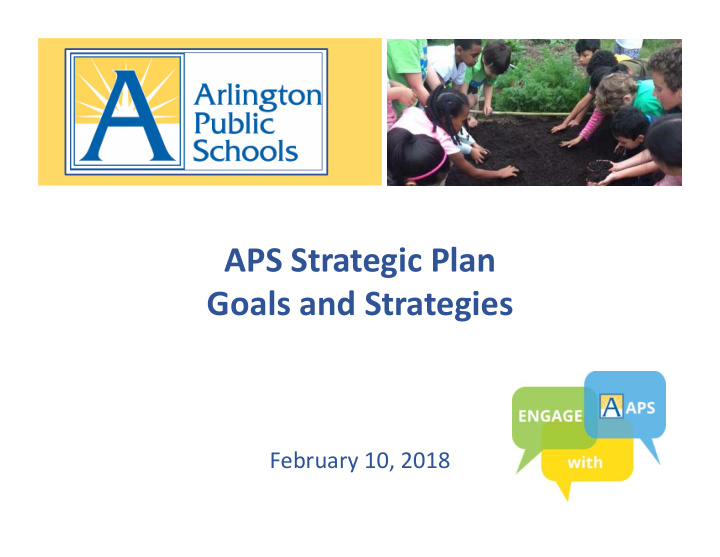



APS Strategic Plan Goals and Strategies February 10, 2018
Strategic Plan Goals Goals : Key areas where we will focus work and resources
Goals ‐ Examples Current APS Strategic Plan Goals: Goal 1: Challenge and Engage All Students Goal 2: Eliminate Achievement Gaps Goal 3: Recruit, Retain and Develop High Quality Staff Goal 4: Provide Optimal Learning Environments Goal 5: Meet the Needs of the Whole Child
Goals ‐ Examples Example goals from other school divisions: • Student Success ‐ We commit to reaching, challenging, and preparing every student for success in school and life. • Student ‐ centered teaching and learning • Improve teaching and learning and provide a strong academic program: Focus on learning, accountability and results. • Develop knowledgeable critical thinkers, communicators, collaborators, creators, and contributors
Strategic Plan Strategies Strategies : steps we intend to take to achieve the goals
Strategies ‐ Examples Current APS Strategies for Challenge and Engage all Students: Present high and clear expectations for all students and include a consistent guide • for the evaluation of student work. Within this framework, APS ensures that a core set of standards ‐ based concepts and competencies form the basis of what all students should learn. Create engaging and motivating educational program choices that prepare • students to achieve college and career aspirations. These choices provide opportunities to: (1) explore, discover, and optimize their individual strengths; (2) recognize and help them overcome their weaknesses; and (3) be evaluated and benchmarked against the best educational systems nationally and internationally. Create an environment where all students feel challenged, supported, and • accepted as they learn. Such an environment puts students first: their needs, abilities, interests, and learning styles are central when making decisions about what to learn and how to learn it. Students are active and responsible participants in their own learning.
Strategies ‐ Examples Current APS Strategies for Meet the Needs of the Whole Child: Increase developmental assets in students. External and internal developmental • assets enhance all children, allowing then to thrive in their health, safety, relationships, long ‐ term development, and academic pursuits. Strengthen family involvement. APS encourages family involvement and feedback • systemically, at all levels of school and district operations, including policy and governance deliberations. Parents are given opportunities to promote the educational, social, and emotional growth of their children. Information and learning events are designed for parents and include strategies developed to reach out and assist them in advocacy and support of their children’s education and growth. Strengthen parent, student, staff, and community partnerships. Parent, student, • staff, and community members are active partners in district programs and governance. Partnership opportunities expand the ability of stakeholders to actively participate in the education of students, to help students effectively navigate the educational system, and to provide support for every student to learn and succeed. Promote, support, and expect strong relationships with students and parents, • making them feel respected and appreciated.
Strategies ‐ Examples Example Strategies from other school divisions: Ensure equity of access to quality core instructional programs and • resources for all students. Empower principals as collaborative instructional leaders to ensure fair • and equitable student outcomes. Make instructional programming decisions by measuring the performance • of all students, including special populations, to ensure all students meet or exceed local, state, and federal accountability standards Acquisition of knowledge, attitudes and skills necessary to understand • personal health and wellness, manage emotions, establish and maintain positive relationships, and make responsible decisions. Graduate students that have the knowledge and skills to qualify for and • succeed in entry level job or credit ‐ bearing postsecondary coursework without the need for remediation.
Potential Goals • Whole Child • Teaching and Learning • Staff • Operational Excellence • Community Partnership
Example Goal and Strategies Goal: Human Capital – APS will invest in teachers, leaders, and staff to ensure we are the place talented educators choose to work Strategies: • Recruit and retain high quality employees who are valued, respected, and rewarded for their efforts • Provide growth and leadership opportunities for all staff by providing meaningful, high ‐ quality, and strategic professional development as well as valuable feedback on performance
Recommend
More recommend